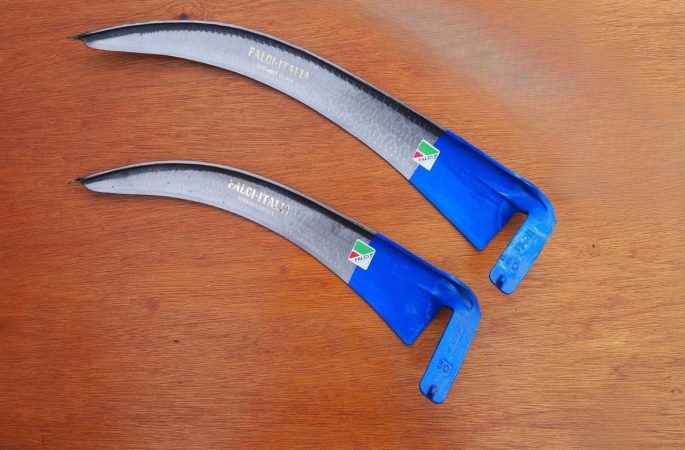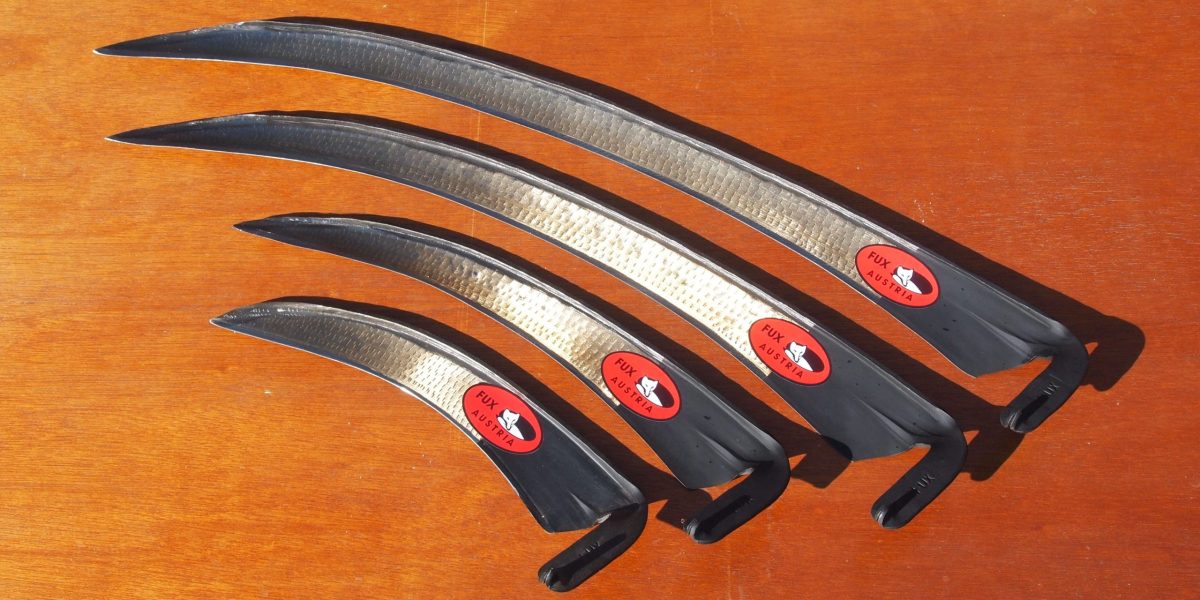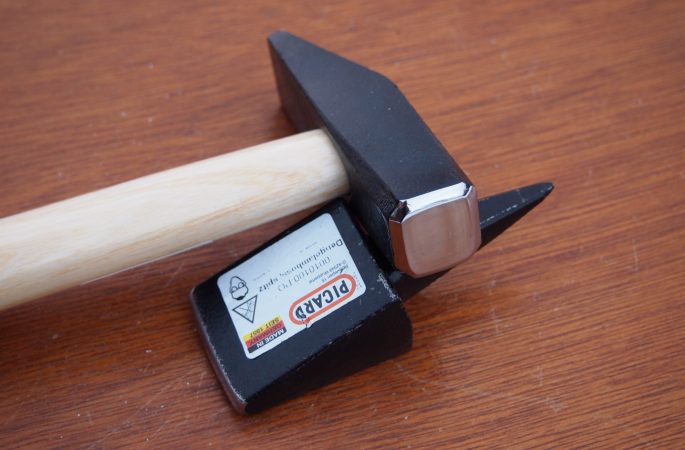We are often asked if it is possible to mow a lawn with a scythe.
The answer is yes and there are many people in the UK doing just that!
Lawn mowing can be a test of a scythers skill.
Here’s our guide to scything lawns to help you on your way.

Lawn Factors
The interplay of the vegetation and the scythe has a big impact on the ease of the work.
Here we consider the challenges of mowing a lawn and how we can make it easier.
Lawns as we know them arose in 17th century England at the homes of large, wealthy landowners.
Beyond the ha-ha, vegetation was controlled with livestock. Close to their homes landowners employed teams of scythers to create close cropped lawns. Only the rich could afford to pay for the labour needed, so a lawn was a mark of wealth and status.

- In general, shorter grass is harder to mow then long grass. It is softer, more pliable and more inclined to bend away from the blade, so it requires better scything and sharpening technique to cut it well.
- Lawns often have a lot of foot traffic, so at least some of the grass will be bent over and lying in lots of different directions. Choosing how to set up your scything takes a little more thought.
- Grass species can also play a part. What is your lawn made of? Thin, dry wiry grasses are more challenging to cut then lusher, broader leaved ones.
Given the above challenges, how can we make it easier to scythe a lawn?
Let it grow…a bit.
As short grass is more challenging to mow, letting your lawn grow longer between mowings will help your learning process a lot.
Have a look at the area you are planning on mowing.
- Do you need a bowling green finish across the whole lawn?
- Can you leave some or all of it longer between mowings?
- If the area is large, can you divide it up and mow parts of it at different intervals?

Helping yourself and wildlife
Decreasing the frequency of mowing and rotating the areas that you mow will make the task easier. You will have less to mow in any one session and it is beneficial to wildlife too.
The wildlife charity Plantlife are encouraging gardeners to think about how they manage their lawns with the No Mow May campaign. Interestingly, you do not need to leave it long and wild to see wildlife benefits
“The highest production of flowers and nectar sugar was on lawns cut once every four weeks. This gives ‘short-grass’ plants like daisies and white clover a chance to flower in profusion, boosting nectar production tenfold.
Areas of longer unmown grass were, however, more diverse in their range of flowers, with other nectar-rich plants like oxeye daisy, field scabious and knapweed increasing the range of nectar sources for different pollinators and extending nectar availability into late summer.”
Plantlife, No Mow May Citizen Science Project
As a result of their citizen science project Plantlife recommend:
- Leaving some areas of your lawn unmown to let taller plants flower.
- Mowing the rest of the lawn once a month. Ideally, rotate the patches that you mow so that there are always some areas in flower.
Of course, this kind of management is ideally suited to the scythe. There’s no need to worry about longer grass clogging up your mower – the scythe can handle it easily!
Combining a Push Mower with a Scythe
If you really want some of your lawn to be a green carpet but find it hard to scythe very short grass well, a combination of a push mower and scythe works well. The push mower can be used on a small area that is cut frequently and kept very short. The rest is managed with the scythe.
Scythes like damp grass
Scythes are not like lawn mowers – it is easier to mow damp grass rather then dry. So the time of day you mow can have a big influence on your mowing.

Early in the morning whilst the dew is still on the grass is ideal, else on a drizzly damp day or in the evening as the dew falls.
It’s not entirely clear why it’s easier to scythe damp grass. Factors might include a lubricating effect of the moisture on the blade as it slices through the grass and a difference in the sap pressure, and therefore the hardness of the grasses.
Look at how the grass is lying
When thinking about how to mow your lawn, it is easier to follow the way the grass is lying rather then trying to mow in straight lines.
- Look carefully at how the grass is lying and mow so that it is leaning away from you and towards the right as much as you can
- Change direction as often as is needed to follow the lie of the grass – you’ll probably end up with lovely sinuous windrows.

We have a small lawn in our private garden, a larger one by the Trust barn and various paths and tracks that are kept mown throughout the growing season.
- No part of this is mown more then six times between April – November.
- A lot of the paths and tracks are only mown four times over this time period, but this is enough to keep them in good condition.
- Some areas are mown just once a season.

Scythe Factors – The Blade
You don’t have to have a specific “lawn mowing” scythe blade.
Most grass blades will manage lawn mowing if well peened and sharpened (see further on).
Below we consider what makes a good lawn blade, how to choose a compromise blade that can manage a wider range of mowing and offer suggestions of blades that are particularly suited to lawn mowing.
Lawn mowing blades need to be able to hold a fine, gradually tapering edge. A Fux Bush Blade is just not going to do it!
A curved belly to the blade (as found in the Falci blades and the Profisense) gives the mower more control over the lay of the blade. (What is the lay?) By lifting or lowering the hands, the mower can “roll” the blade on it’s belly and lower or raise the lay as needed whilst mowing.
An upturn to the tip of the blade can help it ride more easily over uneven ground. Most of the blades we stock have this to a degree. It is more pronounced in the Falci 128 than the Falci 100.
A lighter finer blade is likely to need less peening to maintain a good lawn mowing edge than a heavier one.
As you only carry fairly light amounts of cuttings across each scythe stroke it is easy to use a long blade (70cm or greater) for lawn mowing.
Small lawns, narrow paths or lawns that have a number of trees / bushes to mow around suit shorter blades (60cm or less)
Compromise Blades
Over the years we have built up a large collection of scythe blades, so have the luxury of a large choice!
Many people will be content with one or two blades, selected carefully to cover their mowing needs.

Part of our rather extensive scythe collection.
Factors to consider when choosing a blade
When choosing a blade, look at the range of mowing you will do and make a compromise on length and weight of blade.
- A blade such as a Luxor, a Rasierschnitt or a Styria can be used to mow rougher weeds but still be peened up to mow a lawn.
- You may choose a slighter shorter blade then ideal for lawn mowing, as it will then be more useful for paths and edges.
There is a limit to how far you can stretch one blade.
It is a lot of work to peen a fine edge onto a blade that has been used to bash large areas of mature brambles! And if you try to use a fine edged blade on such vegetation you will just damage it.
If you have a lot of rougher mowing AND a lot of grass mowing it can be easier to have two blades. The edge of each blade can be managed for the vegetation it is used for, saving time and probably resulting in a better job done over all.
For more on selecting the right blades to cover a range of mowing see our Scythe Buyer’s Guide.
Compromise blades – examples
Phil will sometimes choose a compromise blade so that he does not need to switch blades whilst mowing.
- When mowing a friends extensive lawn / meadow / forest garden he will use a 75cm blade. It is long enough to get the mowing done quickly, and whilst a little trickier around the trees it is still perfectly ok for the work.
- In another garden that has a lot of narrow paths he uses a 50cm blade. It’s a bit slower on the areas of lawn, but it gets the job done!
- In areas of our garden, the mowing is mainly grass but the edges contain young brambles, bracken or dock creeping in from the edges. This is better suited to a Luxor blade rather then a lighter blade like the Falci 100.
Our Blade choices
We use our longest blades to mow the barn lawn and vehicle-wide grass tracks. Typically a Luxor 85 or 90cm or Rasierschnitt 95cm.
Smaller areas of lawn and grass paths around 6ft wide are typically mown with a 75cm blade, either a Luxor or a Profisense.
Narrow grass paths less then 4ft wide and grassy edges to brick paths are mown with a 50cm blade, either a Luxor or Falci 100.
Paths that are 4ft-6ft wide might suit a 60-65cm blade better eg a Rasierschnitt or a Falci 100 .
Fine Falci Blades
The Falci meadow blades are a good choice if your lawn is pretty tidy and free of large stones or other hidden obstacles. They are generally finer then the equivalent Fux blade and keep a fine lawn edge for longer between peenings.
Suitable blades are the Falci 128 and the Falci 100.

Grass blades from Fux
The Profisense, Luxor or Rasierscnitt blades from Fux all make good lawn blades. They are a better choice if your lawn is stony or full of toy cars!
The Luxor and Rasierscnitt make good compromise blades, able to handle rougher weeds eg bramble shoots, docks, or bracken shoots that may be creeping into lawn edges.

Scythe Factors – Keep it Sharp
Lawn mowing is a good test of how keen you can get you blade edge.
Shorter grass is flexible and has more tendency to bend away from a blade that is not sharp enough. Frequent use of a sharpening stone whilst mowing and regular peening is needed for an ideal lawn mowing blade edge.
Hone Frequently
Sharpening the blade with a stone (honing) whilst mowing needs to be done frequently. It’s hard to say how often we hone the blade, it much more about feel.
As soon as the blade isn’t cutting as well, we get out the stone and quickly run it over the edge. We probably hone every five minutes or less when mowing soft grass.
It’s quick to do and makes a great difference to your mowing. Hitting a tusky bit of grass can be enough to just take the edge off and justify a quick pass with the stone!

Hone Accurately
Honing needs to be accurate. If you stop to sharpen and find that it hasn’t made much difference, or even made it worse, you may not have managed to catch the edge properly with the stone.
Take your time and make sure you place the stone accurately. Aim to keep the angle of the stone shallow on a finely peened edge so that you don’t round it off.
Here is a guide to honing a scythe blade.
Use a Fine Stone
Use a fine stone to hone your blade. A coarse stone will wear away your nice fine edge too quickly!
The La Saurat stone is good. Beginners find it easier to use and the harshness of it’s honing can be altered by how hard you press.
The Rozutec is a lovely fine stone. It takes a bit more practice to use well. It removes less metal then the Saurat and so preserves your fine peened edge for longer. It is ideal for the more experienced scyther.

Peening is the art of cold hammering the edge of a scythe blade to draw it out and restore the ideal cutting profile.
If you need some background on peening, see this peening guide
A Fine Edge
A fine, gently tapering edge is needed for lawn mowing.
To test if your edge is fine enough, you can use the “thumbnail test”. A fine edge will “ripple” when run on the back of a thumbnail, as demonstrated in this video from Bladerunners.
It is fairly easy to achieve such an edge with the Fux Deluxe Peening Jig or, once practiced, by freehand peening with an anvil. It is possible with the Standard Jig too, although not so easy.
Most mowers begin by using a jig. If you want to move towards free hand peening, use the jig first to establish the bevel, then freehand peen the edge.
Peen Frequently
It is easiest to achieve a good edge with a blade that is frequently peened. Sometimes, a quick edge peen is all that is needed to finesse up an existing edge.
Multiple passes with the jig or the anvil might be needed to get a heavily worked, thickened edge back into a good profile. This can be hard work, as peening work-hardens the edge making each subsequent pass a bit more difficult.

Scything Techniques
Specific scything techniques for short grass.
Mowing short grass is an excellent way to improve your general scything technique. You can see what the blade is doing clearly and if your blade comes off the ground it will miss the grass!
Short grass needs to be cut with a slicing action rather than a chopping one.
- Aim to keep the blade moving in a smooth arc.
- If you are using short strokes on a narrow path or a tight corner ensure the strokes are still following a section of the arc.
This video shows Phil mowing a neat arc.
It is important that the blade stays on the ground for the whole of the cutting stroke. It won’t be cutting anything when it’s is off the ground!
Keep the blade firmly on the ground, aiming to keep the pressure on a point about a third back from the tip of the blade.
- If the pressure is further back, the tip will rise up, the blade will not mow so close and you are more likely to get a visible mowing stripes on your lawn.
- If the pressure is too close to the tip and the tip will have a tendency to dig in.
- It’s common for the tip of the blade to start to rise as you move to the left-hand side of the stroke. Use your right (lower) hand to stop the pressure point from falling back towards the heel of the blade.
We tend to use more downward pressure on the blade when cutting short grass. This keeps it cutting low and helps it “ride” the contours of the ground. Some of our lawns and paths are not very flat!
- Push down with the right hand on the lower grip.
- Use the left hand on the upper grip to support the snath and keep it your usual mowing position.
- If you push down with both hands, the top of the snath will drop and affect the lay of the blade.
Remember to follow the way the grass is laying as you mow.
Because lawns tend to have grass lying in multiple directions it can be hard to pick a mowing line that will get everything in one cut.
This can leave occasional bits that have been squashed by the scythe but are uncut. These bits have an annoying habit of popping up the next day to say hello.
To get a really neat finish you can go back over these bits in a second direction, either right away or when the culprits have popped their heads back up!
Mowing Paths
On narrow paths it is often easier to mow down one side, dropping a windrow at the edge, then turn round and mow back up the other. Often the grass is shorter in the middle where there is more foot traffic.
More Information



